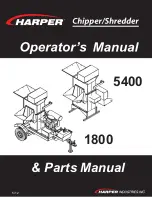
Start-up and Shut-dow n
88
CVHH-SVX001A-EN
occurs in the tem perature of the purge refrigerant exiting
the coil. The com pressor suction tem perature sensor
m onitors this tem perature.
When sufficient non-condensables have accum ulated in
the purge tank to decrease the com pressor suction
tem perature below the pum p-out initiate value, a pum p-
out cycle begins. The cycle is term inated w hen the
com pressor suction tem perature sensor increases above
the pum p-out term inate value. The calculations for the
pum p-out values are:
Pum p-out initiate:
•
(°C) = Purge liquid tem perature (°C) – 10.0°C or -
17.8°C (w hichever is higher)
•
(°F) = Purge liquid tem perature (°F) – 50°F or 0°F
(w hichever is higher)
Pum p-out term inate:
•
(°C) = Purge liquid tem per ature (°C) – 4.4°C or -
15.0°C (w hichever is higher)
•
(°F) = Purge liquid tem perature (°F) – 40°F or 5°F
(w hichever is higher)
The purge liquid tem perature value com es from the
chiller ’s saturated condenser tem perature sensor w hen
the chiller is running, or the chiller ’s saturated evaporator
tem perature sensor w hen the chiller is off.
Non-condensable Pump-out cycle
A non-condensable pum p-out cycle m ay be initiated as
described below only if the follow ing tw o conditions are
m et:
•
A carbon regeneration cycle is NOT in process, and
•
The refrigeration circuit is on.
If at any tim e, except as described above, the purge
refrigerant com pressor suction tem perature drops below
the pum p-out initiate value, the follow ing sequence is
initiated by the controls.
The controller starts the pum p-out com pressor and opens
the exhaust solenoid valve. After 5 seconds, the pum p-out
solenoid valve opens and pulses at a rate of 20 seconds On
and 20 seconds Off. If, after tw o cycles, the purge
refrigerant com pressor suction tem perature has not
exceeded the pum p-out term inate value, the pum p-out
solenoid valve stays continuously open. If the pum p-out
com pressor runs for m ore than 10 consecutive m inutes,
the controller recalculates the pum p-out initiate and
pum p-out term inate values as described.
The purge controls continue to operate the pum p-out
solenoid valve and calculate values as described above
until the purge refrigerant com pressor suction
tem perature rises above the pum p-out term inate value. At
this point, the controller w ill close the pum p-out solenoid
valve and turn off the pum p-out com pressor and exhaust
solenoid valve.
N ot e: For purge system s equipped w ith standard pum p-
out com pressors, operation at low chiller
condenser saturation tem peratures m ay result in a
system vacuum greater than the pum p-out
com pressor can overcom e. If the chiller
experiences low condensing tem peratures, then
the Tracer UC800 controller can be program m ed to
inhibit the operation of the purge pum p-out
com pressor.
Carbon Tank and Regeneration Subsystem
The function of the carbon tank is to absorb refrigerant
m olecules that m ay be entrained in the discharge of non-
condensables. In order to m aintain effectiveness, the
carbon tank periodically regenerates.
Carbon Regeneration Algorithm
The controller uses the carbon regeneration algorithm to
determ ine w hen to initiate, control, and term inate a
carbon regeneration cycle. The carbon bed tem perature
sensor serves as the feedback to this algorithm . In
addition, the controller uses a pum p-out accum ulation
tim er to indicate the rem aining carbon capacity in the
carbon tank. The carbon capacity is the capacity of the
carbon to adsorb refrigerant w hile m aintaining acceptable
levels of refrigerant em ission through the chiller vent line.
A capacity of 100 percent m eans the carbon bed has the
capacity to adsorb refrigerant and m aintain acceptable
em ission levels. A capacity of 0 percent m eans the carbon
bed has inadequate capacity to adsorb refrigerant and still
m aintain acceptable em ission levels.
The m ain objectives of the carbon regeneration algorithm
are to:
•
M inim ize the am ount of refrigerant contained in the
carbon by perform ing a periodic regeneration.
•
Regenerate to m aintain low em issions levels.
•
M inim ize the regeneration tim e.
•
Regenerate only w hen the chiller is at a m inim um level
of purging activity.
•
Allow regeneration to occur w ith the chiller On or Off.
Regeneration is preferable w hen the chiller is On to
ensure low carbon tank pressure, but regeneration is
also acceptable w hen the chiller is Off.
The rem aining am ount of absorption capacity w ithin the
carbon tank is directly proportional to the num ber of purge
pum p-out m inutes that have accum ulated, and is also a
function of the chiller refrigerant type. The purge carbon
tank on an R-1233
zd
(E)-equipped chiller is considered to be
fully saturated after the purge has accum ulated
350 m inutes of pum p-out tim e. Because the relationship
betw een pum p-out capacity and pum p-out m inutes is
directly proportional, it can be described by the follow ing
equation w ithin the regeneration algorithm :
Rem aining carbon capacity% =
100 - (pum p-out m inutes since last regen/pum p-out
m inutes at 100% capacity)* 100
Содержание CVHH
Страница 110: ......
















































